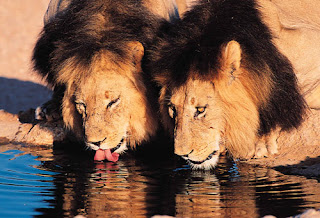Number 83 Eastern Gray Kangaroos
 A kangaroo is a marsupial from the family Macropodidae. In common use the term is used to describe the largest species from this family, the Red Kangaroo, the Antilopine Kangaroo, and the Eastern and Western Grey Kangaroo of the Macropus genus. The family also includes many smaller species which include the wallabies, tree-kangaroos, wallaroos, pademelons and the Quokka, some 63 living species in all.Kangaroos are endemic to the continent of Australia, while the smaller macropods are found in Australia and New Guinea.
A kangaroo is a marsupial from the family Macropodidae. In common use the term is used to describe the largest species from this family, the Red Kangaroo, the Antilopine Kangaroo, and the Eastern and Western Grey Kangaroo of the Macropus genus. The family also includes many smaller species which include the wallabies, tree-kangaroos, wallaroos, pademelons and the Quokka, some 63 living species in all.Kangaroos are endemic to the continent of Australia, while the smaller macropods are found in Australia and New Guinea.The kangaroo is an Australian icon: it is featured on the Australian Coat of Arms, on some currency, and is used by many Australian organizations, including Qantas.
Before European settlement, the kangaroo was a very important animal for Australian Aborigines, for its meat, hide, bones and sinews. In addition, there were important Dreaming stories and ceremonies involving the kangaroo. Aherrenge is a current kangaroo dreaming site in the Northern Territory. The game of Marn grook was played using a ball made from kangaroo by the Kurnai people.
Unlike many of the smaller macropods, kangaroos have fared well since European settlement. European settlers cut down forests to create vast grasslands for sheep and cattle grazing, added stock watering points in arid areas, and have substantially reduced the number of dingoes.
Kangaroos are shy and retiring by nature, and in normal circumstances present no threat to humans. Male kangaroos often "box" amongst each other, playfully, for dominance, or in competition for mates. The dexterity of their forepaws is utilised in both punching and grappling with the foe, but the real danger lies in a serious kick with the hindleg. The sharpened toenails can disembowel an opponent.
There are very few records of kangaroos attacking humans without provocation, however several such unprovoked attacks in 2004 spurred fears of a rabies-like disease possibly affecting the marsupials. The only reliably documented case of a fatality from a kangaroo attack occurred in New South Wales, in 1936. A hunter was killed when he tried to rescue his two dogs from a heated fray. Other suggested causes for erratic and dangerous kangaroo behaviour include extreme thirst and hunger.
In 2004, Lulu, an Eastern Grey, saved a farmer's life. She received the RSPCA National Animal Valor Award on May 19 of that year.
The female kangaroo is usually pregnant in permanence, except on the day she gives birth; however, she has the ability to freeze the development of an embryo until the previous joey is able to leave the pouch. This is known as diapause, and will occur in times of drought and in areas with poor food sources. The composition of the milk produced by the mother varies according to the needs of the joey. In addition, the mother is able to produce two different kinds of milk simultaneously for the newborn and the older joey still in the pouch.
Unusually, during a dry period, males will not produce sperm, and females will only conceive if there has been enough rain to produce a large quantity of green vegetation.
Kangaroos and wallabies have large, stretchy tendons in their hind legs. They store elastic strain energy in the tendons of their large hind legs, providing most of the energy required for each hop by the spring action of the tendons rather than by any muscular effort. This is true in all animal species which have muscles connected to their skeleton through elastic elements such as tendons, but the effect is more pronounced in kangaroos.















